constituent assembly of india debates (proceedings)- volume vii
constituent assembly of india debates (proceedings)- volume vii
constituent assembly of india debates (proceedings)- volume vii
You also want an ePaper? Increase the reach of your titles
YUMPU automatically turns print PDFs into web optimized ePapers that Google loves.
the Provincial Government was in respect <strong>of</strong> a few subjects like higher education, medical aid etc., other<br />
than the subjects <strong>of</strong> defense, external affairs and communications which were not provincial subjects. In<br />
the Mikir Hills and in the North Cachar Hills, which are the least vocal and advanced <strong>of</strong> the areas under<br />
consideration, there would probably be satisfaction if control over land and local customs and<br />
administration <strong>of</strong> justice are left to the local people. The Khasi Hills proposals were for a federation <strong>of</strong> the<br />
States and British portions; otherwise the proposals were similar to those made for the Garo Hills. A<br />
feeling common to all <strong>of</strong> the Hill Districts is that people <strong>of</strong> the same tribe should be brought together<br />
under a common administration. This has led to a demand for rectification <strong>of</strong> boundaries. The Lushai<br />
want the Kuki <strong>of</strong> Manipur and other areas in their boundaries, the Naga want the Zemi areas <strong>of</strong> the North<br />
Cachar Hills included in their district and so on.<br />
5. POLITICAL EXPERIENCE -<br />
Except for the Municipality <strong>of</strong> Shillong, there are no statutory local self-governing bodies in any <strong>of</strong> the<br />
Hill Districts. The partially excluded areas have elected representatives in the provincial legislature but in<br />
the Garo Hills the franchise is limited to the Nokmas and in the Mikir Hills to the headmen. Generally,<br />
however, the tribes are all highly democratic in the sense that their village councils are created by<br />
general assent or election. Chiefship among certain tribes like the Lushai is hereditary (although certain<br />
chiefs have been appointed by the Superintendent) but among other tribes appointment <strong>of</strong> headmen is<br />
by common consent or by election or, in some cases, selection from particular families. Disputes are<br />
usually settled by the Chief or headman or council <strong>of</strong> elders. In the Naga Hills what is aimed at is general<br />
agreement in settling disputes. Allotment <strong>of</strong> land for jhumis generally the function <strong>of</strong> the Chiefs or<br />
headmen (except in the Khasi & Jaintia Hills) and there are doubtless many other matters pertaining to<br />
the life <strong>of</strong> the village which are dealt with by the chiefs or elders, but while this may form a suitable<br />
background for local self-government the tribes altogether lack experience <strong>of</strong> modern self-governing<br />
institutions. The "District Conference" <strong>of</strong> the Lushai Hills, the tribal council <strong>of</strong> the North Cachar Hills and<br />
the Naga National Council are very recent essays in organising representative bodies for the district as a<br />
whole and have no statutory sanction. While there is no doubt that the Nag a, Lushai, Khasi and Garo<br />
will be able to manage a large measure <strong>of</strong> local autonomy, the North Cachar tribes and the Mikir may yet<br />
want a period <strong>of</strong> supervision and guidance.<br />
6. THE SPECIAL FEATURES -<br />
Whatever the capacity <strong>of</strong> the different councils or conferences to manage the affairs <strong>of</strong> the areas may be,<br />
the general proposals for the administration <strong>of</strong> these areas must be based upon the following<br />
considerations: -<br />
(a) The distinct social customs and tribal organisations <strong>of</strong> the different peoples as well as their<br />
religious beliefs. For instance, the Khasi and the Garo have a matriarchal system, the Lushai have<br />
hereditary chiefs, the Ao Naga have got the council <strong>of</strong> elders called `Tatar' which his periodically<br />
renewed by election. The laws <strong>of</strong> succession <strong>of</strong> the Lushai permit the youngest son <strong>of</strong> the family to<br />
succeed to the property <strong>of</strong> his father. Similarly, in the case <strong>of</strong> the Garo, the youngest daughter gets her<br />
mother's property and so on. Christianity has made considerable headway among the Lushai, Khasi and<br />
the Garo, but large numbers <strong>of</strong> the hill people still continue their own tribal forms <strong>of</strong> worship which some<br />
people describe as `animism'.<br />
(b) The fear <strong>of</strong> exploitation by the people <strong>of</strong> the plains on account <strong>of</strong> their superior organisation and<br />
experience <strong>of</strong> business, the hill people fear that if suitable provisions are not made to prevent the people<br />
<strong>of</strong> the plains from acquiring land in the hill areas, large numbers <strong>of</strong> them will settle down and not only<br />
occupy land belonging to the hill people but will also exploit them in the non-agricultural pr<strong>of</strong>essions.<br />
Thus, the hill people seem to attach special value to the present system <strong>of</strong> an`Inner Line' to cross which<br />
non-tribals entering the area require a pass, and the provisions prohibiting non-tribals from settling down


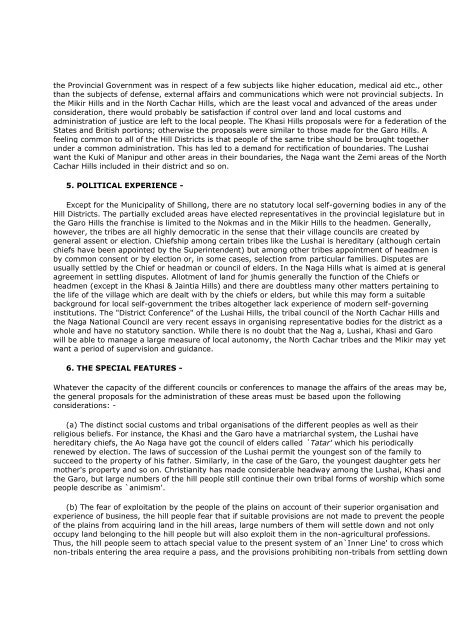
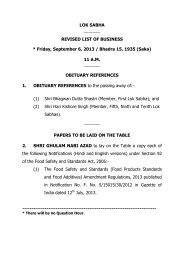
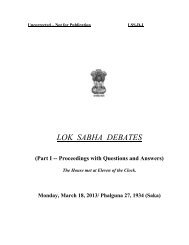

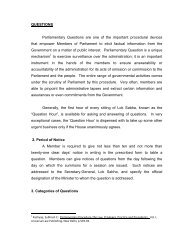
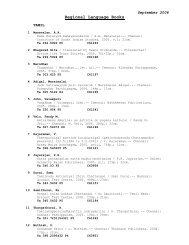

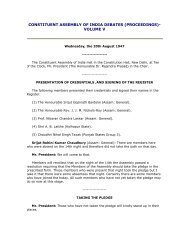
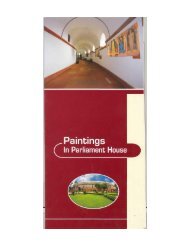
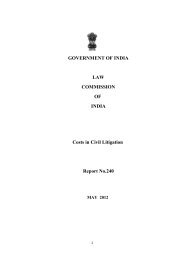
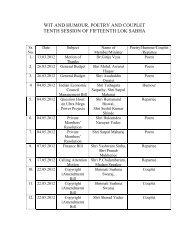
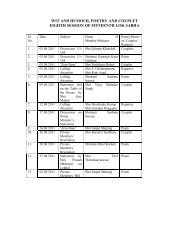

![gÉÉŌ A.]ÉŌ. xÉÉxÉÉ](https://img.yumpu.com/8015720/1/190x245/geeo-aeo-xeexee.jpg?quality=85)
